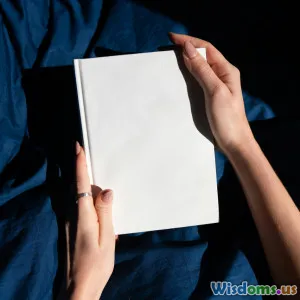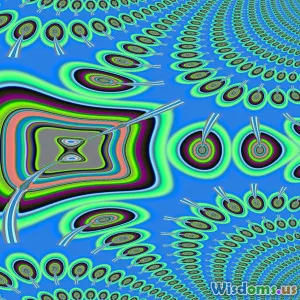Unlock Creative Solutions by Tracking Nightly Thought Patterns
9 min read Discover how tracking your nightly thoughts can unlock fresh creative solutions and enhance problem solving skills through practical methods and real-world insights. (0 Reviews)Unlock Creative Solutions by Tracking Nightly Thought Patterns
Creativity isn’t confined to daylight hours or moments of sudden inspiration. Often, the seeds of breakthrough ideas are sown during the quiet, enigmatic hours of the night. Have you ever woken up already holding a solution to a problem that seemed impossible the day before? Your brain, even while you sleep, is swirling through information and forging connections. Unlocking this hidden stream by tracking your nightly thought patterns can revolutionize how you approach problems and innovate.
This article explores how understanding and documenting the mental processes you experience at night can enhance creativity, supported by neuroscience, practical tracking methods, and real-world stories that bring these abstract concepts vividly to life.
The Night’s Mind: A Creative Powerhouse
Understanding Nightly Thought Patterns
As you drift into sleep, your conscious mind fades, but your subconscious remains active, engaging in complex cognitive activity. Research in sleep science reveals that phases like Rapid Eye Movement (REM) sleep are particularly fertile grounds for abstract thinking and problem-solving.
Dr. Matthew Walker, a leading sleep scientist, highlights that during REM sleep, the brain's neural networks reorganize information, often leading to novel insights upon waking. Moreover, the interplay between memories and emotions during this phase enhances associative thinking, a core ingredient of creativity.
This means your brain is naturally solving puzzles and recombining ideas while you rest, making nightly thoughts a goldmine for innovation.
Creativity Beyond Wakefulness
Notable creators like Nikola Tesla and Salvador Dalí reportedly harnessed hypnagogic states—the transitional phase between wakefulness and sleep—to tap into unique ideas. Tesla is said to have envisioned inventions fully formed in these liminal spaces, while Dalí scheduled short naps to collect surreal imagery from his subconscious.
By intentionally monitoring and decoding these nightly reflections, anyone can access creativity that extends beyond the limitations of daytime rational thought.
Tracking Nightly Thought Patterns: Methods to Capture the Invisible
Journaling Immediately Upon Waking
One of the simplest yet most effective methods to harness nightly thoughts is journaling immediately upon waking. Even fragmented impressions can be clues to underlying creative ideas.
Example: Nobel laureate Otto Loewi reportedly woke up with the idea that led to his major scientific discovery and wrote it down instantly, ensuring that his subconscious insight wasn’t lost.
To implement this, keep a notebook or voice recorder at your bedside. The first moments of waking are critical because the mind quickly shifts into a more analytical, discursive mode.
Using Digital Tools for Pattern Recognition
Beyond simple journaling, modern technology offers apps designed to log dreams and cognitive reflections. Tools like DreamKeeper allow tagging of recurring themes, emotions, and ideas to identify subconscious patterns.
Data analytics can reveal which concepts surface regularly at night, enabling deliberate exploration and creative problem framing during the day.
Mindfulness and Pre-Sleep Reflection
Preparing the mind before sleep influences thought patterns in significant ways. Reflecting consciously on a problem or creative challenge just before rest—sometimes called 'incubation'—primes your subconscious to chew on these problems overnight.
Supporting this, a study published in Psychological Science found that participants who engaged in focused problem statements before sleep were up to 30% more likely to find solutions during REM cycles.
Pairing such targeted reflection with systematic recording creates a feedback loop: conscious intention meets subconscious synthesis.
Decoding Nightly Thought Data: Turning Patterns Into Solutions
Identifying Recurring Symbols and Themes
Once collected, review your nightly records to find repeated images, metaphors, or mental scripts. These often hint at unresolved issues or conceptual breakthroughs.
For instance, a software developer tracking dreams noticed recurring images of labyrinth-like mazes. Upon introspection, these symbolized complex project challenges. Using this metaphor, the developer redesigned workflows into clearer, streamlined processes, drastically improving productivity.
Linking Emotional Undercurrents to Innovation
Emotions in nightly thoughts can sensitively signal areas needing attention or fresh ideas. Fear and frustration might mark problem spots, while feelings of excitement could highlight nascent creative direction.
Famous artist Frida Kahlo used her nighttime emotions and imagery to inform her vivid paintings, connecting raw subconscious feelings to tangible creative works.
Collaborative Approaches to Nightly Insight
Sharing nightly thought patterns within creative teams can foster collective innovation. When members share recurring motifs or solutions 'dreamt' overnight, it broadens problem-framing and fosters cross-pollination of ideas.
Google's '20% time' practice, encouraging employees to engage in personal creative projects, sometimes revolves around sleep hygiene and nighttime ideation, unlocking breakthroughs from diverse perspectives.
Practical Tips to Get Started
- Cultivate a Sleep-Friendly Environment: Quality sleep amplifies REM phases, where creativity is most potent. Dim lights, avoid screens an hour before bedtime, and maintain consistent sleep schedules.
- Develop a Night Thought Ritual: Before sleeping, clearly state or write down a specific challenge you want your mind to explore.
- Keep a Journal Ready: Choose the medium—paper or digital—that best suits you for capturing early-morning insights swiftly.
- Review Patterns Weekly: Set a routine to analyze recorded thoughts, looking for themes and creative sparks.
- Be Patient and Persistent: Like any skill, interpreting nightly thoughts requires practice and openness to subconscious messaging.
Conclusion: Embrace the Night as a Creative Ally
Tracking nightly thought patterns is more than a fascinating self-experiment—it’s a gateway to accessing a richer creative reservoir hidden within your mind’s nocturnal domain. Through strategic journaling, mindfulness before sleep, and pattern recognition, the mysterious workings of your sleeping brain convert from fleeting images into feasible innovations.
The night need not be a temporal void. Instead, it can become your subconscious collaborator, solving challenges and inspiring originality when you learn to listen and track the intangible signals delivered during slumber.
Take heart from the trailblazers who preceded you and start your own journey tonight. Unlock your mind’s untapped potential and watch as creative solutions emerge long after the sun goes down.
References:
- Walker, M. (2017). Why We Sleep. Scribner.
- Cai, D. J., Mednick, S. A., Harrison, E. M., Kanady, J. C., & Mednick, S. C. (2009). REM, not incubation, improves creativity by priming associative networks. Proceedings of the National Academy of Sciences, 106(25), 10130-10134.
- Schooler, J. W., & Melcher, J. (1995). The seduction of insight: Mental set and mental plasticity in creative problem solving. Journal of Experimental Psychology: General, 124(2), 218.
Rate the Post
User Reviews
Other posts in Dream Journaling and Analysis
Popular Posts

















